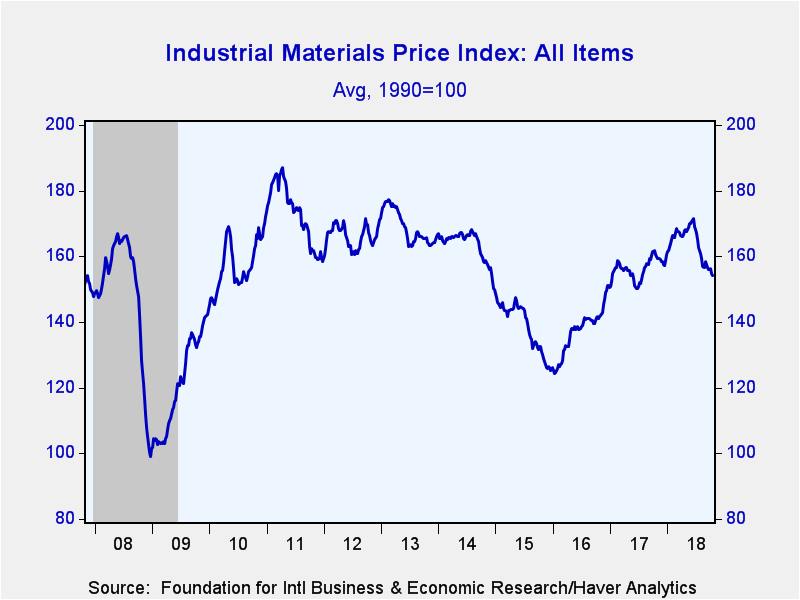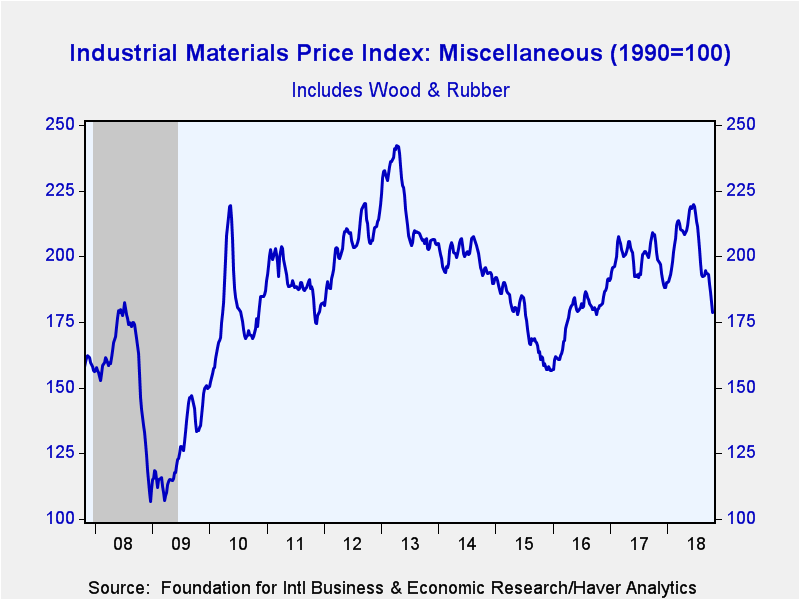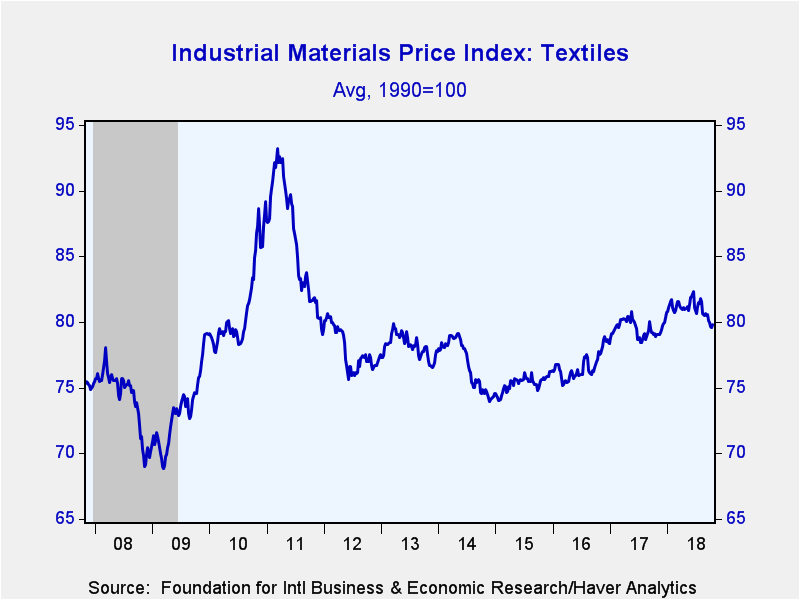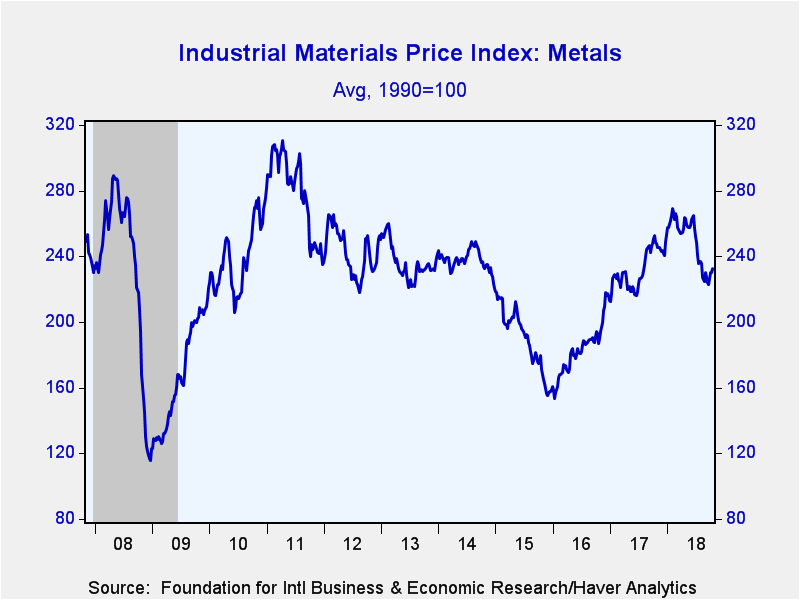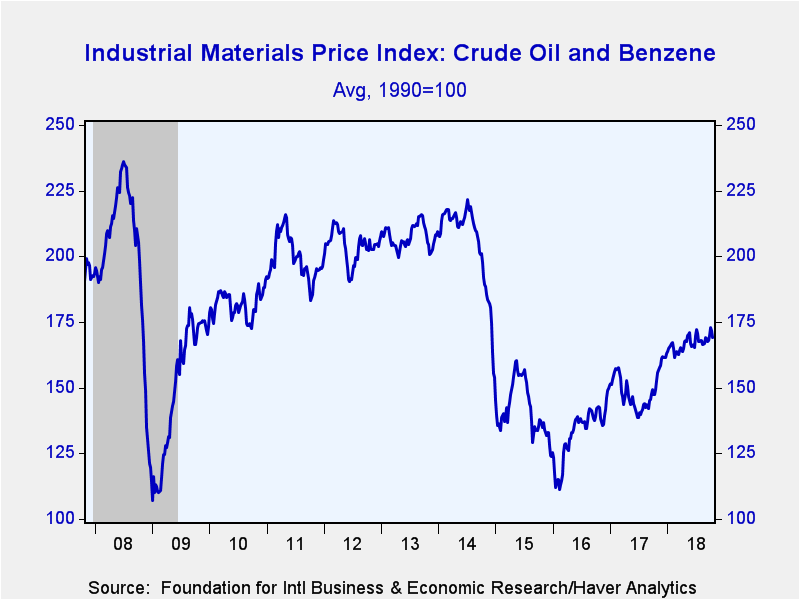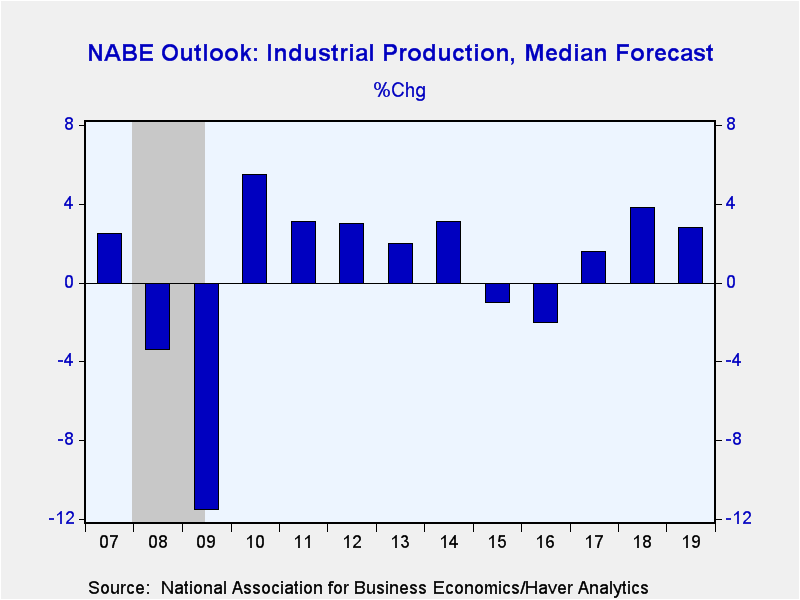 Global| Oct 22 2018
Global| Oct 22 2018FIBER: Industrial Commodity Prices Fall Further
by:Tom Moeller
|in:Economy in Brief
Summary
The Industrial Materials Price Index from the Foundation for International Business and Economic Research (FIBER) declined 1.3% during the last four weeks and extended the decline in prices since the peak four months ago. The decline [...]
The Industrial Materials Price Index from the Foundation for International Business and Economic Research (FIBER) declined 1.3% during the last four weeks and extended the decline in prices since the peak four months ago. The decline left the index down 4.1% during the last year. During the last ten years, there has been a 66% correlation between the y/y change in industrial commodity prices and the y/y change in factory sector production.
Recent weakness in commodity prices was led by a 7.6% m/m decline in prices (-13.2% y/y) in the miscellaneous group. Leading the downdraft were framing lumber prices which fell 15.4% m/m. Prices for structural panels declined 10.1% m/m and 20.3% y/y. Natural rubber prices, however, reversed earlier declines with a 2.2% four-week rise (-0.3% y/y). Prices in the textile group dipped again with a 0.3% four-week decline (+1.2% y/y) paced by a 1.9% drop in cotton prices (+13.2% y/y). Burlap prices (used for rope & nets) were little changed (-2.4% y/y).
Metals prices worked 4.4% higher during the last four weeks (-6.5% y/y). The gain was led by zinc prices which increased 12.8% m/m, but fell 18.5% y/y. Steel scrap prices rose 8.1% m/m and by roughly one quarter y/y. Copper scrap prices increased 4.3% m/m but fell 10.4% y/y. The cost of aluminum rose 1.1% m/m although it declined 4.8% y/y. Lead prices improved 0.4% m/m (-18.9% y/y). Also increasing were prices in the crude oil & benzene group by 0.7% m/m and 13.4% y/y. Crude oil prices gained 1.0% during the last four weeks and roughly one-third y/y to an average $70.73 per barrel, the highest price since November 2014. Accompanying the rise in crude oil prices were benzene costs which gained 1.5% m/m (4.5% y/y).
Improvement in prices overall may be coming. The consensus forecast from the National Association for Business Economics (NABE) calls for a 3.8% rise in industrial output during all of 2018 and 2.8% growth in 2019. During the last ten years, there has been a 66% correlation between the y/y change in industrial commodity prices and the y/y change in factory sector output. In addition, factory sector production in the European Union and Japan continues to improve.
Commodity price data can be found in Haver's DAILY, WEEKLY, USECON and CMDTY databases. The NABE forecast is in the SURVEYS database.
| FIBER Industrial Materials Price Index (%) | 1-Mth | 3-Mth | 6-Mth | 12-Mth | 2017 | 2016 | 2015 |
|---|---|---|---|---|---|---|---|
| All Items | -1.3 | -5.4 | -8.3 | -4.1 | 6.7 | 19.2 | -16.3 |
| Textiles | -0.3 | -2.0 | -1.4 | 1.2 | 3.0 | 2.8 | 2.2 |
| Cotton (cents per pound) | -1.9 | -12.3 | -5.7 | 13.2 | 9.8 | 10.2 | 2.6 |
| Metals | 4.4 | -1.3 | -11.9 | -6.5 | 18.6 | 32.9 | -27.8 |
| Aluminum ($ per metric ton) | 1.1 | -3.0 | -17.0 | -4.8 | 26.0 | 13.0 | -19.2 |
| Copper Scrap (cents per pound) | 4.3 | 2.3 | -9.0 | -10.4 | 29.3 | 17.3 | -27.0 |
| Steel Scrap ($ per ton) | 8.1 | -4.2 | -17.3 | 26.7 | 16.8 | 74.5 | -53.8 |
| Crude Oil & Benzene | 0.7 | 1.0 | 1.0 | 13.4 | 8.1 | 20.4 | -19.4 |
| Crude Oil (WTI, $ per Barrel) | 1.0 | 2.6 | 4.7 | 36.6 | 10.9 | 44.3 | -35.8 |
| Miscellaneous | -7.6 | -13.9 | -14.3 | -13.2 | -0.5 | 21.7 | -18.0 |
| Framing Lumber ($ per 1000 board ft.) | -15.4 | -29.9 | -24.5 | 15.2 | 20.0 | 12.9 | -16.4 |
| Natural Rubber (cents per pound) | 2.2 | 3.0 | -4.9 | -0.3 | -29.6 | 89.4 | -22.5 |
Tom Moeller
AuthorMore in Author Profile »Prior to joining Haver Analytics in 2000, Mr. Moeller worked as the Economist at Chancellor Capital Management from 1985 to 1999. There, he developed comprehensive economic forecasts and interpreted economic data for equity and fixed income portfolio managers. Also at Chancellor, Mr. Moeller worked as an equity analyst and was responsible for researching and rating companies in the economically sensitive automobile and housing industries for investment in Chancellor’s equity portfolio. Prior to joining Chancellor, Mr. Moeller was an Economist at Citibank from 1979 to 1984. He also analyzed pricing behavior in the metals industry for the Council on Wage and Price Stability in Washington, D.C. In 1999, Mr. Moeller received the award for most accurate forecast from the Forecasters' Club of New York. From 1990 to 1992 he was President of the New York Association for Business Economists. Mr. Moeller earned an M.B.A. in Finance from Fordham University, where he graduated in 1987. He holds a Bachelor of Arts in Economics from George Washington University.


